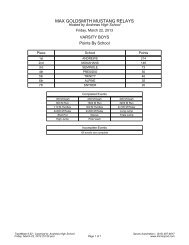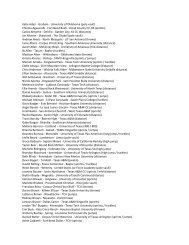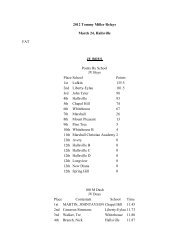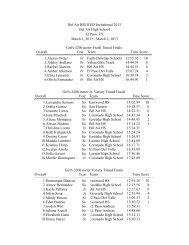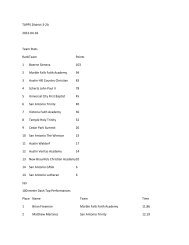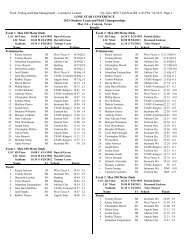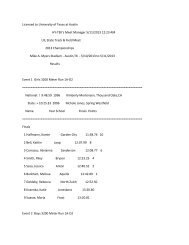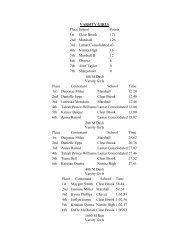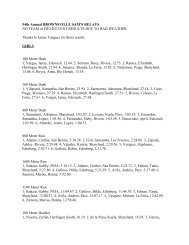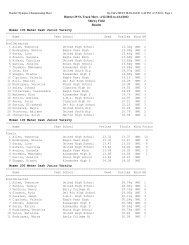1. PAGES 1-35 - Texas Track & Field Coaches Association
1. PAGES 1-35 - Texas Track & Field Coaches Association
1. PAGES 1-35 - Texas Track & Field Coaches Association
Create successful ePaper yourself
Turn your PDF publications into a flip-book with our unique Google optimized e-Paper software.
MENTAL IMAGERY<br />
In addition, a qualitative component was added for more<br />
detailed results. At the end of the study, during an individual<br />
session scheduled with the researcher, athletes responded to<br />
the following prompt:<br />
Do you feel that the imagery exercises in which you have<br />
engaged throughout the course of this study had any effect<br />
on your levels of confidence in your specific event or sport as<br />
a whole? Explain in detail the extent to which the imagery<br />
had an effect on your confidence. In addition, please indicate<br />
whether or not you intend to continue the use of<br />
imagery on your own following the conclusion of this study<br />
and your reasons for doing so or not.<br />
Athletes were given as much time as needed to respond in<br />
as much detail as possible.<br />
PROCEDURES<br />
Pre-intervention. Before beginning imagery exercises, an initial<br />
TSCI was administered to each athlete. Participants<br />
received instructions on which types of imagery they should<br />
focus on and on how much time they should devote to the<br />
exercises each week. They then underwent a preliminary,<br />
researcher-led relaxation and imagery session, in order to<br />
experience the techniques and types of imagery to be used<br />
throughout the six-week intervention. Finally, the researcher<br />
answered any questions the athletes had regarding the study<br />
before the intervention period began.<br />
Intervention. Participants in the study were required to<br />
engage in weekly MG-M imagery exercises associated with<br />
control and confidence. The researcher explained that MG-M<br />
imagery involved imaging the entire process associated with<br />
mastering a difficult situation in a specific event, including<br />
specific details, such as the weather, the scenery and feelings<br />
and emotions that may occur during the event. Athletes were<br />
told to engage in relaxation techniques before going through<br />
any imagery exercise. The relaxation techniques involved<br />
finding a quiet, comfortable location to sit or lie down.<br />
Athletes were told to follow a relaxation script provided to<br />
them in audio and in written format (Price-Evans, 2010). The<br />
relaxation script involved deep breathing exercises meant to<br />
release tension and calm the athlete prior to their imagery<br />
session. After a five- to 10-minute relaxation session, athletes<br />
would begin their MG-M imagery exercises, using as much<br />
detail as possible.<br />
Athletes followed this general intervention procedure at<br />
least four times each week for six weeks. The athletes were<br />
required to provide details about personal imagery sessions<br />
at least three times each week in a provided imagery journal.<br />
The journals served to immediately reinforce the athletes’<br />
imagery. To ensure that the athletes understood the goals of<br />
the imagery exercises, they scheduled one structured imagery<br />
session each week with the researcher to go through the<br />
intervention procedure and imagery session as well as to<br />
38 techniques AUGUST 2011



